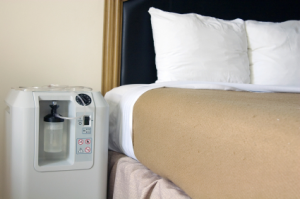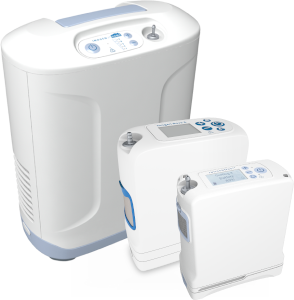
When deciding what kind of oxygen concentrator is best for you, it is important to determine with your doctor what kind of oxygen delivery best meets your needs: pulse dose vs. continuous flow.
Pulse Dose vs. Continuous Flow: The Difference[1]
Pulse dose (PD) oxygen delivery is based on breathing and inhaling, which customizes your oxygen delivery to your breath rate.
Continuous flow (CF), on the other hand, delivers oxygen at a constant adjustable rate, indiscriminate of the user’s breathing, measured in liters per minute.
Pulse dose output is determined by the size of the individual pulse (called a bolus) and is measured in milliliters per breath, rather than liters per minute.
Much of the oxygen in continuous flow unit may be wasted simply because we exhale and pause between breaths. Pulse units are designed to produce a pulse when it senses when you are inhaling or taking a breath.
For a continuous flow portable oxygen concentrator, think of it like a water fountain: If an individual stands in front of a water fountain flowing at 1 liter per minute, they don’t actually drink one full liter of water. The amount of water a person drinks is determined by the number of sips and the size of the sip. The rest of the water is wasted. The same applies to continuous flow oxygen; the net amount of oxygen inhaled is a combination of the flow rate, the number of breaths and the size of the breaths.
Pulse dose oxygen is more sophisticated. Pulse dose mechanisms are more sensitive, utilizing an oxygen conserver and other technology to deliver oxygen to the patient based on breathing rate and other factors. The sensor determines when the patient begins inhaling and delivers the oxygen pulse/bolus at that moment. Pulse dosing is more akin to a glass of water with a straw than a fountain; the intake will be based purely on the amount and intensity of sips. When an oxygen concentrator is said to be a “single-solution” for on-the-go, at home and during sleep, it usually employs pulse dose oxygen technology so that it can deliver the proper amount of oxygen during all phases of daily activity and during rest. [2]
Choosing Between Pulse Dose vs. Continuous Flow Oxygen
When it is time to choose the right oxygen concentrator for you, talk to your doctor about whether pulse dosing or continuous flow oxygen delivery is better for your needs. Based on this difference between pulse dose vs. continuous flow oxygen, it is also important to consider how you would like to use the oxygen: on the go, at home or just for sleep. Pulse dose oxygen concentrators seem to be preferable for doing a number of different things, but continuous flow portable oxygen concentrators may be a sufficient option, particularly if breathing will remain relatively constant.[3]
Pulse Dose vs. Continuous Flow Oxygen: How Inogen Can Help
Only your health care providers can help you decide between pulse dose vs. continuous flow oxygen for your oxygen therapy. Your doctor will make the decision based on how active you are, how much oxygen you will need per day and how frequently you will need oxygen therapy treatments. For many patients requiring supplemental oxygen, an oxygen concentrator will work well, and your doctor will direct you toward a continuous flow portable oxygen concentrator or a pulse dose portable oxygen concentrator.
Inogen provides oxygen concentrator solutions for both portable and stationary use to help you get the oxygen you need, when you need it.
The Inogen At Home is one of the lightest, home oxygen concentrators available, often coming in at half the weight of other home concentrators in use today, making it easy to bring with you whatever room of the house you are in. Inogen at home is also extremely energy efficient. At a flow setting of 2, it used just 100W of energy, the same as a standard 100W light bulb.. If you and your doctor decide a continuous flow portable oxygen concentrator is required for your oxygen needs, the Inogen At Home may be an excellent choice.
Our Inogen One portable oxygen concentrator series offers Intelligent Delivery Technology pulse dose oxygen in several lightweight portable models to meet your needs. Inogen One portable oxygen concentrators allow you to carry your pulse dose oxygen with you so you can receive your oxygen therapy all day, every day, at home or away. With Inogen oxygen concentrators, you will experience peace of mind and mobility whether you are at home, on the go or traveling. If you are unsure which Inogen One model best fits your needs, ask your doctor about flow settings and battery life, and then compare the models to find your best fit.
Once you have chosen the right portable oxygen concentrator for you, whether it offers pulse dosing or continuous flow, the final factor is consulting with your physician and health care provider to establish an oxygen therapy plan. Make sure that you are comfortable with your oxygen therapy plan, including where and how it will be implemented, and ensuring that it helps you breathe better and improves your quality of life. Once you have a treatment plan in place, or when you first start considering oxygen therapy options, contact Inogen to find out how our continuous flow portable oxygen concentrator and pulse dose portable oxygen concentrator products can help you.
References
- https://www.copdfoundation.org/COPD360social/Community/COPD-Digest/Article/232/Questions-about-Portable-Oxygen-Concentrators.aspx
- Nocturnal Oxygenation Using a Pulsed-Dose Oxygen-Conserving Device Compared to Continuous Flow; Robert L Chatburn, Joseph S Lewarski, Robert W McCoy; Respiratory Care Mar 2006, 51 (3) 252-256;
- Hardavella G, Karampinis I, Frille A, Sreter K, Rousalova I. Oxygen devices and delivery systems. Breathe (Sheff). 2019 Sep;15(3):e108-e116. doi: 10.1183/20734735.0204-2019. PMID: 31777573; PMCID: PMC6876135.







